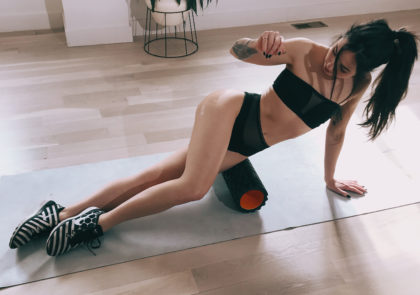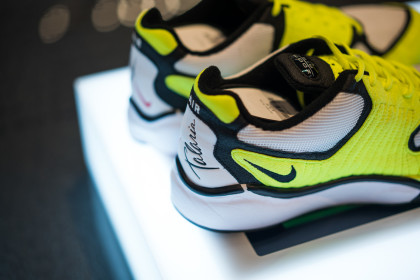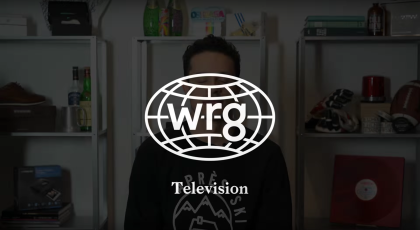
Saskia Haex
Editors note: Saskia Haex and I first met in Paris in 2011. We were the only two girls competing in a Fixed Freestyle event during the Bicycle Film Festival. She taught me the lazy barspin and bonding ensued. Of course, my new found go-to trick notwithstanding, Saskia went on to beat me and take first place. She fearlessly schooled me and even a few of the men competing. But not on purpose. She did it because she just loves to ride. And she’ll try just about anything be it on her bike or in her creative atelier. This girl is electric and her enthusiasm is completely contagious, which is why I was so excited when she agreed to sit down and talk about her other love: art.
“The inspiration for my artwork comes from very basic feelings, experiences and ideas.”
Originally from Weert, a small city not far from Eindhoven in the Netherlands, Rotterdam based artist Saskia Haex has made quite a name for herself in the Dutch art scene. Be it running with Bitches in Control (now defunct), playing around with new graphic styles and typographies, organizing events or espousing her creative expertise in the classroom, this multi-talented handicrafter is a force to be reckoned with.
WRG: For those who might not be familiar with your work, can you describe what you do and where your inspiration comes from?
Saskia Haex: My work is often a combination of hand drawn typography and illustration. I screen print a lot too, mostly on paper or fabric. It also happens that clients approach me for three-dimensional projects. Lately, I’ve been making a lot of installations and objects with my best friend, Marianne Lock. But generally the inspiration for my artwork comes from very basic feelings, experiences and ideas. Humour and positivity are a really important element my to work as well.
WRG: When did you get into drawing, graphic design and creating art?
SH: Ok, this is going to sound very cheesy, but i was really just one of those kids who started drawing at a young age. I’ve always loved doing arts and crafts and making things with my hands, and it’s just never stopped. But as a teen I never really thought that I could turn this passion of mine into a real job. That I could actually live off it. Somehow though, I did end up in art school. It had a lot to do with my graffiti friends back in Eindhoven actually. They taught me all about the D.I.Y. mentality, that if you want something really badly, you should just go for it.
WRG: What were some of the other D.I.Y tricks you learnt during your graffiti period?
SH: I learnt about the many different ways I could reproduce my artwork. Like making stencils, thinner prints, screen printing, painting big lettering with roller paint and so on… Hanging out and sketching with my graffiti friends changed my views on lettering as well. I started to see a word as an image instead of “just” a group of letters.

Back then, some guys in my city got really productive and started organizing events. There wasn’t that much going on in town so they initiated all kinds of projects, parties and exhibitions. It was actually because of them that I got into organizing events as well.
WRG: And besides those event organizers, who have been among your influences? Who’s work did you look up to when you were younger?
SH: As a kid I never really had an artist that I particularly looked up too. At that point, making things was more about trying out certain techniques and materials. Later on, I looked up to the local graffiti heroes like SOL crew, TSC and Betamaxxx, and then there were also artists making crossovers between graffiti and illustration like Honet and Finsta. I was pretty inspired by graffiti artists crossing over to hand lettering too, and sometimes I now even get inspired by advertising. Work by Steven Powers (Espo) for example.
But these days my main favourites are Margaret Kilgallen and some others artists from “Beautiful Losers“. David Hockney too. Lina Stigsson, Letman, Neck Face…
WRG: And now have your own studio in Rotterdam, and you’re a teacher in graphic design. Which do you prefer?
SH: If I could, I would rather just have the studio. But teaching is a good thing too. By teaching you can actually learn quite a lot. Talking about art, design and ideas doesn’t just help the students, it actually helps me when I start work on new ideas too.
WRG: How did you get into teaching?
SH: Well, my interest in teaching started when i was a teenager. I would help out at my little sisters primary school. And then when I finished art school I felt that I needed some kind of back up plan in case I completely failed at becoming a career artist. So I got my teaching degree.
In the end, it turned out to be the right decision. But not because I failed at my career as an artist. Because i really like teaching! It’s a really rewarding job and it grants me a certain stability in terms of my income which is always nice. Right now, I teach graphic design at an art college in Amsterdam and then I also teach screen printing at the local university as well.
WRG: Looking back on what you learned in art school, compared to what kids are learning today, have things changed?
SH: The basics are still the same. It all starts with a good idea!
WRG: Can you talk about some of your favourite projects that you’ve been involved in so far in your career?
SH: Co-operating with other artists is always a lot of fun. One of my favourite works right now are the “Trouble comes in a 6-pack” screenprint I made together with Otto Baum, member of Klub7 – the zombie t-shirt I drew for Hell Yeah – and the horse me and Marianne made recently for an exhibition about horses.
But I am also really proud of the exhibitions and cultural projects I worked on over the years which you can check out online.
WRG: What are you working on at the moment?
SH: Different pieces for the Fiend art festival in Antwerp. Several t-shirt graphics for bike friends and companies. And then there’s my own brand of apparel called Snakebite. We just release a new tee and there’s another one on the way!
WRG: Alright. And when you’re not at your studio or teaching a class, where can we find you?
SH: Outside. Riding.
WRG: Of course! So, does riding fixed influence your work at all then?
SH: A lot of the things i like, love and hate are referred to in my work. So yes. Cycling is a reoccurring theme as well as an inspiration. So is transportation and maps. In the future I’d like to blend my work and my passion for cycling more. By working together with cycling companies to develop graphics and apparel for men and women.
[Images provided by Saskia Haex. For more info on Snake Bite click here. To view more of Saskia’s other work, click here]
Editors note: Saskia Haex and I first met in Paris in 2011. We were the only two girls competing in a Fixed Freestyle event during the Bicycle Film Festival. She taught me the lazy barspin and bonding ensued. Of course, my new found go-to trick notwithstanding, Saskia went on to beat me and take first place. She fearlessly schooled me and even a few of the men competing. But not on purpose. She did it because she just loves to ride. And she'll try just about anything be it on her bike or in her creative atelier. This girl is electric and her enthusiasm is completely contagious, which is why I was so excited when she agreed to sit down and talk about her other love: art.
"The inspiration for my artwork comes from very basic feelings, experiences and ideas."
Originally from Weert, a small city not far from Eindhoven in the Netherlands, Rotterdam based artist Saskia Haex has made quite a name for herself in the Dutch art scene. Be it running with Bitches in Control (now defunct), playing around with new graphic styles and typographies, organizing events or espousing her creative expertise in the classroom, this multi-talented handicrafter is a force to be reckoned with.
WRG: For those who might not be familiar with your work, can you describe what you do and where your inspiration comes from?
Saskia Haex: My work is often a combination of hand drawn typography and illustration. I screen print a lot too, mostly on paper or fabric. It also happens that clients approach me for three-dimensional projects. Lately, I've been making a lot of installations and objects with my best friend, Marianne Lock. But generally the inspiration for my artwork comes from very basic feelings, experiences and ideas. Humour and positivity are a really important element my to work as well.
WRG: When did you get into drawing, graphic design and creating art?
SH: Ok, this is going to sound very cheesy, but i was really just one of those kids who started drawing at a young age. I've always loved doing arts and crafts and making things with my hands, and it’s just never stopped. But as a teen I never really thought that I could turn this passion of mine into a real job. That I could actually live off it. Somehow though, I did end up in art school. It had a lot to do with my graffiti friends back in Eindhoven actually. They taught me all about the D.I.Y. mentality, that if you want something really badly, you should just go for it.
WRG: What were some of the other D.I.Y tricks you learnt during your graffiti period?
SH: I learnt about the many different ways I could reproduce my artwork. Like making stencils, thinner prints, screen printing, painting big lettering with roller paint and so on... Hanging out and sketching with my graffiti friends changed my views on lettering as well. I started to see a word as an image instead of “just” a group of letters.

Back then, some guys in my city got really productive and started organizing events. There wasn’t that much going on in town so they initiated all kinds of projects, parties and exhibitions. It was actually because of them that I got into organizing events as well.
WRG: And besides those event organizers, who have been among your influences? Who's work did you look up to when you were younger?
SH: As a kid I never really had an artist that I particularly looked up too. At that point, making things was more about trying out certain techniques and materials. Later on, I looked up to the local graffiti heroes like SOL crew, TSC and Betamaxxx, and then there were also artists making crossovers between graffiti and illustration like Honet and Finsta. I was pretty inspired by graffiti artists crossing over to hand lettering too, and sometimes I now even get inspired by advertising. Work by Steven Powers (Espo) for example.
But these days my main favourites are Margaret Kilgallen and some others artists from "Beautiful Losers". David Hockney too. Lina Stigsson, Letman, Neck Face...
WRG: And now have your own studio in Rotterdam, and you're a teacher in graphic design. Which do you prefer?
SH: If I could, I would rather just have the studio. But teaching is a good thing too. By teaching you can actually learn quite a lot. Talking about art, design and ideas doesn’t just help the students, it actually helps me when I start work on new ideas too.
WRG: How did you get into teaching?
SH: Well, my interest in teaching started when i was a teenager. I would help out at my little sisters primary school. And then when I finished art school I felt that I needed some kind of back up plan in case I completely failed at becoming a career artist. So I got my teaching degree.
In the end, it turned out to be the right decision. But not because I failed at my career as an artist. Because i really like teaching! It’s a really rewarding job and it grants me a certain stability in terms of my income which is always nice. Right now, I teach graphic design at an art college in Amsterdam and then I also teach screen printing at the local university as well.
WRG: Looking back on what you learned in art school, compared to what kids are learning today, have things changed?
SH: The basics are still the same. It all starts with a good idea!
WRG: Can you talk about some of your favourite projects that you've been involved in so far in your career?
SH: Co-operating with other artists is always a lot of fun. One of my favourite works right now are the "Trouble comes in a 6-pack" screenprint I made together with Otto Baum, member of Klub7 – the zombie t-shirt I drew for Hell Yeah – and the horse me and Marianne made recently for an exhibition about horses.
But I am also really proud of the exhibitions and cultural projects I worked on over the years which you can check out online.
WRG: What are you working on at the moment?
SH: Different pieces for the Fiend art festival in Antwerp. Several t-shirt graphics for bike friends and companies. And then there's my own brand of apparel called Snakebite. We just release a new tee and there's another one on the way!
WRG: Alright. And when you're not at your studio or teaching a class, where can we find you?
SH: Outside. Riding.
WRG: Of course! So, does riding fixed influence your work at all then?
SH: A lot of the things i like, love and hate are referred to in my work. So yes. Cycling is a reoccurring theme as well as an inspiration. So is transportation and maps. In the future I'd like to blend my work and my passion for cycling more. By working together with cycling companies to develop graphics and apparel for men and women.
[Images provided by Saskia Haex. For more info on Snake Bite click here. To view more of Saskia's other work, click here]





